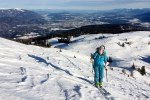News
Darkness is worth protecting
The large-scale illumination of ski slopes, snow-making facilities and construction sites: light pollution has increased by about 70 per cent since the end of the 1990s in the Alpine region. As a result, there are few places left where the night sky is not illuminated by artificial lighting. “In the Alps, the proportion of completely dark forests at night varies between four per cent in the western central Alps and 16 per cent on the southern flank of the Alps. The last large areas of total darkness are not in the forest area but in the areas above the alpine tree line,” writes Mario F. Broggi, former President of CIPRA International, in the German magazine “Nationalpark”.
Star parks and light sanctuaries
Areas with little artificial lighting are therefore becoming increasingly important. This gave rise to the idea of light sanctuaries. These are places that are protected from light pollution and allow the observation of a natural, dark sky. The UNESCO Biosphere Reserve Rhön/D, the Gantrisch Nature Park near Bern/CH or the Upper Bavarian Winklmoos-Alm/D are so-called star parks that sensitise their guests to the natural phenomenon of the night sky, the protection of nocturnal animals and the efficient use of energy: while the cross-border, Austrian-Italian “Skyscape” project aims to develop new tourist products about darkness. Observing the night sky and experiencing the intact, undisturbed night landscape in selected areas of the Alps will be the main focus.
Sources and further information:
Dunkelheit und Stille (Nationalpark, de), Immer mehr Licht stört die Dunkelheit der Nacht ( BR Wissen, de), Wo man in Bayern noch Sterne sehen kann (Süddeutsche, de), Damit es in Bayern wieder mal Nacht wird (Süddeutsche, de), Die Folgen der Lichtverschmutzung (Paten der Nacht, de), «Lichtverschmutzung» in den Alpen wird zum Problem (Tagesanzeiger, de), Positionspapier Lichtverschmutzung (Mountain Wilderness Schweiz, de), Initiative gegen Lichtverschmutzung (de), Analyse der Lichtemissionen der Schweiz 2019 – weiterhin Zunahme der Lichtverschmutzung (Dark Sky Switzerland, de) The new world atlas of artificial night sky brightness (en) Interreg Projekt «Skyscape»



